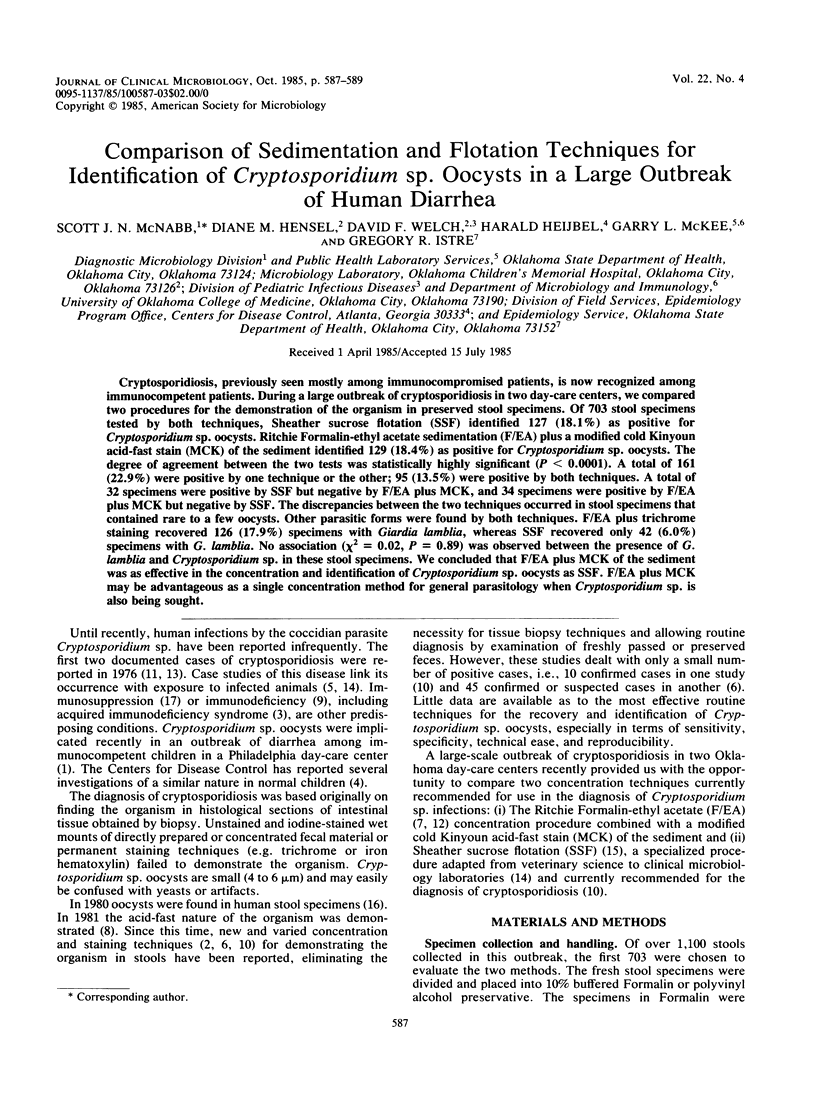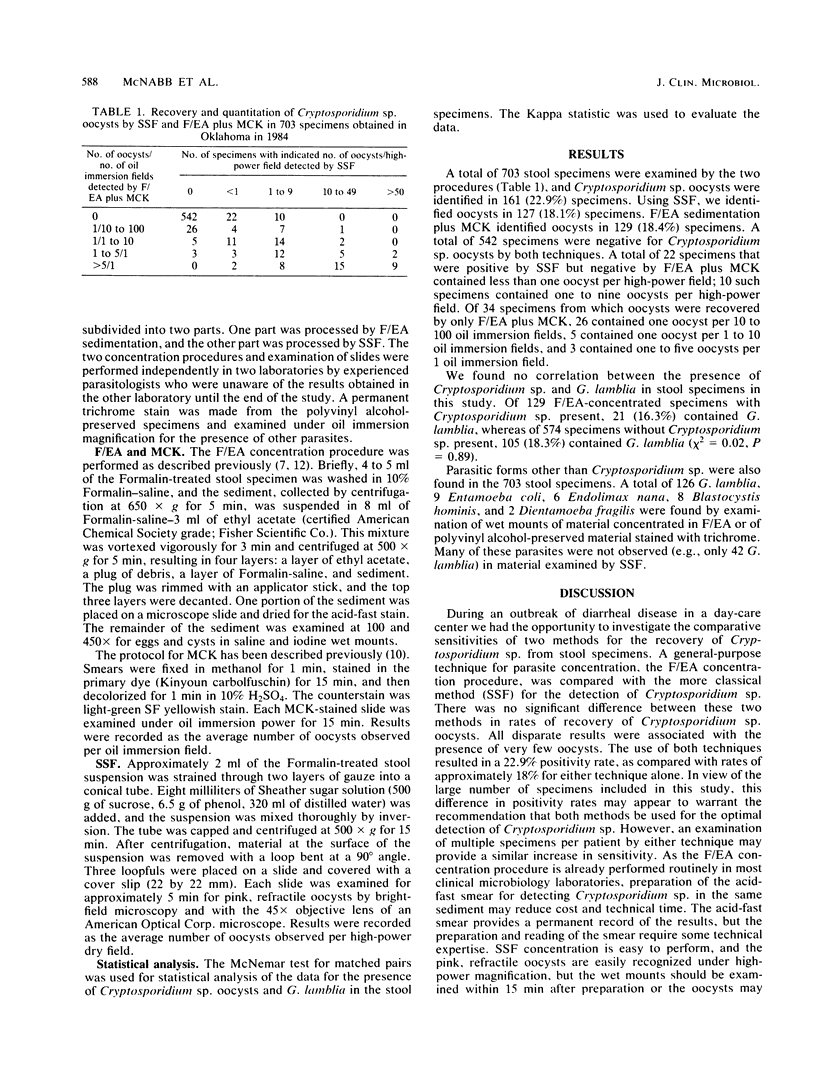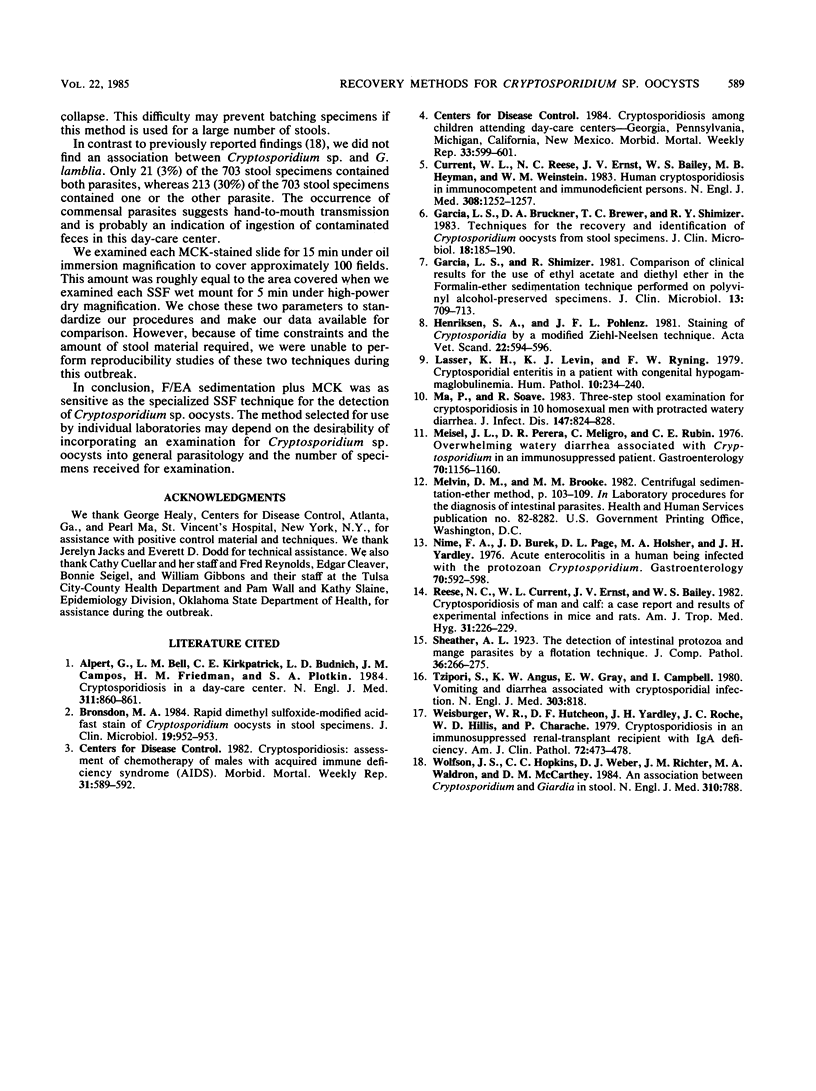Abstract
Cryptosporidiosis, previously seen mostly among immunocompromised patients, is now recognized among immunocompetent patients. During a large outbreak of cryptosporidiosis in two day-care centers, we compared two procedures for the demonstration of the organism in preserved stool specimens. Of 703 stool specimens tested by both techniques, Sheather sucrose flotation (SSF) identified 127 (18.1%) as positive for Cryptosporidium sp. oocysts. Ritchie Formalin-ethyl acetate sedimentation (F/EA) plus a modified cold Kinyoun acid-fast stain (MCK) of the sediment identified 129 (18.4%) as positive for Cryptosporidium sp. oocysts. The degree of agreement between the two tests was statistically highly significant (P less than 0.0001). A total of 161 (22.9%) were positive by one technique or the other; 95 (13.5%) were positive by both techniques. A total of 32 specimens were positive by SSF but negative by F/EA plus MCK, and 34 specimens were positive by F/EA plus MCK but negative by SSF. The discrepancies between the two techniques occurred in stool specimens that contained rare to a few oocysts. Other parasitic forms were found by both techniques. F/EA plus trichrome staining recovered 126 (17.9%) specimens with Giardia lamblia, whereas SSF recovered only 42 (6.0%) specimens with G. lamblia. No association (chi 2 = 0.02, P = 0.89) was observed between the presence of G. lamblia and Cryptosporidium sp. in these stool specimens. We concluded that F/EA plus MCK of the sediment was as effective in the concentration and identification of Cryptosporidium sp. oocysts as SSF. F/EA plus MCK may be advantageous as a single concentration method for general parasitology when Cryptosporidium sp. is also being sought.
Full text
PDF


Selected References
These references are in PubMed. This may not be the complete list of references from this article.
- Alpert G., Bell L. M., Kirkpatrick C. E., Budnick L. D., Campos J. M., Friedman H. M., Plotkin S. A. Cryptosporidiosis in a day-care center. N Engl J Med. 1984 Sep 27;311(13):860–861. doi: 10.1056/nejm198409273111320. [DOI] [PubMed] [Google Scholar]
- Bronsdon M. A. Rapid dimethyl sulfoxide-modified acid-fast stain of Cryptosporidium oocysts in stool specimens. J Clin Microbiol. 1984 Jun;19(6):952–953. doi: 10.1128/jcm.19.6.952-953.1984. [DOI] [PMC free article] [PubMed] [Google Scholar]
- Current W. L., Reese N. C., Ernst J. V., Bailey W. S., Heyman M. B., Weinstein W. M. Human cryptosporidiosis in immunocompetent and immunodeficient persons. Studies of an outbreak and experimental transmission. N Engl J Med. 1983 May 26;308(21):1252–1257. doi: 10.1056/NEJM198305263082102. [DOI] [PubMed] [Google Scholar]
- Garcia L. S., Bruckner D. A., Brewer T. C., Shimizu R. Y. Techniques for the recovery and identification of Cryptosporidium oocysts from stool specimens. J Clin Microbiol. 1983 Jul;18(1):185–190. doi: 10.1128/jcm.18.1.185-190.1983. [DOI] [PMC free article] [PubMed] [Google Scholar]
- Garcia L. S., Shimizu R. Comparison of clinical results for the use of ethyl acetate and diethyl ether in the formalin-ether sedimentation technique performed on polyvinyl alcohol-preserved specimens. J Clin Microbiol. 1981 Apr;13(4):709–713. doi: 10.1128/jcm.13.4.709-713.1981. [DOI] [PMC free article] [PubMed] [Google Scholar]
- Henriksen S. A., Pohlenz J. F. Staining of cryptosporidia by a modified Ziehl-Neelsen technique. Acta Vet Scand. 1981;22(3-4):594–596. doi: 10.1186/BF03548684. [DOI] [PMC free article] [PubMed] [Google Scholar]
- Lasser K. H., Lewin K. J., Ryning F. W. Cryptosporidial enteritis in a patient with congenital hypogammaglobulinemia. Hum Pathol. 1979 Mar;10(2):234–240. doi: 10.1016/s0046-8177(79)80012-x. [DOI] [PubMed] [Google Scholar]
- Ma P., Soave R. Three-step stool examination for cryptosporidiosis in 10 homosexual men with protracted watery diarrhea. J Infect Dis. 1983 May;147(5):824–828. doi: 10.1093/infdis/147.5.824. [DOI] [PubMed] [Google Scholar]
- Meisel J. L., Perera D. R., Meligro C., Rubin C. E. Overwhelming watery diarrhea associated with a cryptosporidium in an immunosuppressed patient. Gastroenterology. 1976 Jun;70(6):1156–1160. [PubMed] [Google Scholar]
- Nime F. A., Burek J. D., Page D. L., Holscher M. A., Yardley J. H. Acute enterocolitis in a human being infected with the protozoan Cryptosporidium. Gastroenterology. 1976 Apr;70(4):592–598. [PubMed] [Google Scholar]
- Reese N. C., Current W. L., Ernst J. V., Bailey W. S. Cryptosporidiosis of man and calf: a case report and results of experimental infections in mice and rats. Am J Trop Med Hyg. 1982 Mar;31(2):226–229. doi: 10.4269/ajtmh.1982.31.226. [DOI] [PubMed] [Google Scholar]
- Tzipori S., Angus K. W., Gray E. W., Campbell I. Vomiting and diarrhea associated with cryptosporidial infection. N Engl J Med. 1980 Oct 2;303(14):818–818. [PubMed] [Google Scholar]
- Weisburger W. R., Hutcheon D. F., Yardley J. H., Roche J. C., Hillis W. D., Charache P. Cryptosporidiosis in an immunosuppressed renal-transplant recipient with IgA deficiency. Am J Clin Pathol. 1979 Sep;72(3):473–478. doi: 10.1093/ajcp/72.3.473. [DOI] [PubMed] [Google Scholar]
- Wolfson J. S., Hopkins C. C., Weber D. J., Richter J. M., Waldron M. A., McCarthy D. M. An association between cryptosporidium and giardia in stool. N Engl J Med. 1984 Mar 22;310(12):788–788. [PubMed] [Google Scholar]


